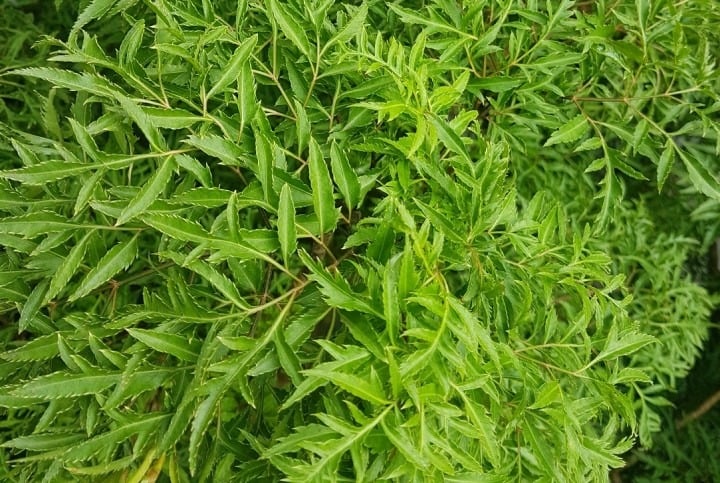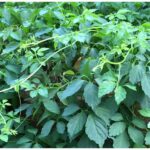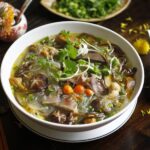The image of vibrant green fences with Polyscias fruticosa, or the “ding lang” plant, is deeply ingrained in the memories of many Vietnamese, especially those from rural areas. Once considered a common wild plant, few knew that it held a wealth of nutritional value and could become a beloved delicacy.
Today, ding lang is no longer confined to the countryside; it has made its way into the urban landscape, bringing a touch of rustic charm to modern life.
Ding Lang – A Unique Delicacy from its Leaves and Roots
The leaves of the ding lang plant are slender and delicate, growing in an alternating pattern and emitting a gentle, pleasant aroma. Young leaves have a mild astringent taste with a hint of bitterness, but as you chew, a distinctive nutty and spicy flavor emerges. In Vietnamese cuisine, these leaves are prized as a herb and are commonly used in traditional dishes from all three regions of the country.

In Northern Vietnam, ding lang leaves are often paired with the famous sour meat dish of Phu Tho province, as well as various fish salads, creating a harmonious balance of flavors.
In Central Vietnam, the iconic “banh trang cuon thit heo” (rice paper rolls with pork) and the renowned “banh trang phoi suong Trang Bang” would not be complete without ding lang leaves, as they impart a distinctive flavor.
In the Mekong Delta region of Southern Vietnam, ding lang leaves are a perfect complement to the crispy “banh xeo” (Vietnamese savory pancakes), creating an unforgettable culinary experience.
Beyond its culinary uses, ding lang leaves are also valued in traditional medicine for their nourishing and digestive properties. Fresh ding lang leaves command a high price, selling for approximately 90,000 VND per kilogram.
Not only the leaves but also the roots of the ding lang plant have gained popularity in recent years. A unique type of jam made from these roots has taken the online market by storm. This delicacy is priced at a premium, roughly 400,000 VND per kilogram. The process of making this jam is laborious and time-consuming, requiring 7-8 kilograms of ding lang roots to produce just 1 kilogram of jam, using only the softest part of the roots.
The steps to make ding lang jam are similar to those of traditional jams. First, high-quality roots are selected, cleaned, and then grated. The most challenging part is grating the roots to achieve the right thickness for the jam while avoiding the woody fibers.
For jam production, only the roots of the ding lang plant with soft leaves (also known as “la nep”) that are over five years old are used. The sweetness in the jam comes from a combination of honey and sweetgrass, along with the natural sweetness of the roots, making it suitable even for diabetics.
Nutritional Components and Outstanding Benefits of Ding Lang
The ding lang plant is a nutritional powerhouse, containing valuable components such as alkaloids, glycosides, saponins, flavonoids, tannins, vitamin B, and essential amino acids like lysine, cysteine, and methionine. Research has revealed that all parts of the plant possess high medicinal value and offer a plethora of health benefits:

Allergy and Food Poisoning Relief: Drinking a decoction made from ding lang leaves daily helps alleviate allergy symptoms like itching, hives, and redness.
Postpartum Care for Women: Soup made with ding lang leaves and meat or fish aids in nutrient absorption and supports postpartum recovery.
Lactation Support: A decoction of fresh ding lang leaves stimulates milk production and helps clear blocked milk ducts.
Detoxification and Skin Conditions: The decoction also serves as a detoxifying agent, aiding in the treatment of acne and itchy skin rashes.
Headache Relief: Combining the leaves and stems of ding lang with white angelica and brewing them into a tea helps alleviate headaches.
Wound Healing: Fresh ding lang leaves, when crushed and applied topically, reduce inflammation and mild infections in wounds.
Rheumatism and Joint Pain: A concoction made from ding lang leaves, stems, and roots, along with “la lot” leaves and “ke dau ngu” (a type of herb), helps alleviate pain associated with rheumatism.
Menstrual Regulation: A decoction made from the leaves and branches of the ding lang plant helps regulate menstrual cycles, stabilizes hormones, and reduces menstrual cramps.
Digestive Disorders: The same decoction also improves digestion and alleviates symptoms like bloating, indigestion, and mild diarrhea.
Precautions When Using Ding Lang
While ding lang offers a myriad of health benefits, it is important to use it in moderation. The leaves contain saponins, and excessive consumption can lead to side effects such as dizziness and weakness. Therefore, it is crucial to consume ding lang in appropriate quantities to maximize its benefits while ensuring safety.
The Pork Cut Treasured by American Experts: A Nutritional Powerhouse Equivalent to Chicken Breast, Beloved in Vietnamese Cuisine.
Pork, a staple meat in Vietnamese cuisine, has been lauded by American nutrition experts for its nutritional value, even drawing comparisons to chicken breast. This cut of meat is now being hailed as a nutritional powerhouse, with a protein content comparable to that of chicken. Discover the nutritional secrets and learn how to prepare this versatile meat.
Ginseng for the Masses: Air-Purifying, Easy-to-Grow Wonder Herb
For centuries, Vietnamese people have revered the Echinophora as a precious herbal medicine, earning it the nickname “the poor man’s ginseng.” Recent studies have also unveiled this plant’s impressive ability to filter fine dust, making it the ideal choice for creating a green and healthy living environment.



































